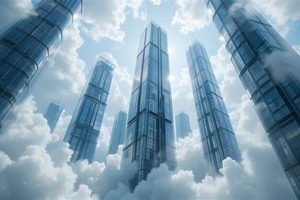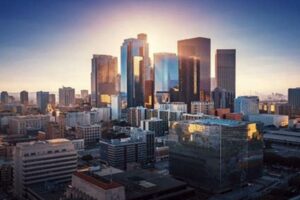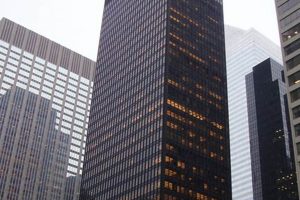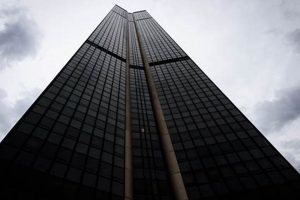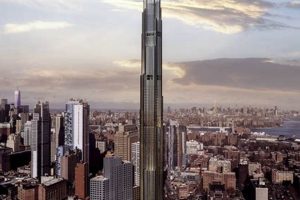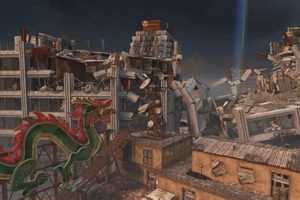Skyscraper painting is the process of painting the exterior of high-rise buildings. It is a specialized trade that requires specialized skills and equipment. Skyscraper painters must be able to work at great heights and in all weather conditions.
Skyscraper painting is important for several reasons. First, it protects the building’s exterior from the elements. Second, it can improve the building’s appearance. Third, it can help to increase the building’s energy efficiency.
The history of skyscraper painting dates back to the early 20th century, when the first skyscrapers were built. At that time, skyscraper painters used brushes and rollers to apply paint to the building’s exterior. Today, skyscraper painters use a variety of specialized equipment, including sprayers and lifts.
1. Safety
Safety is of the utmost importance in skyscraper painting due to the significant heights involved. Skyscraper painters must undergo rigorous training in fall protection and other safety procedures to mitigate the risks associated with working at such elevations. This training ensures that they have the knowledge and skills necessary to work safely and efficiently, minimizing the likelihood of accidents or injuries.
Fall protection systems, such as harnesses, lifelines, and scaffolding, are crucial for skyscraper painters. These systems provide a secure connection to the building and prevent falls in the event of a misstep or equipment failure. Regular inspections and maintenance of safety equipment are also essential to ensure their reliability and effectiveness.
Skyscraper painters must also be aware of the potential hazards posed by weather conditions, such as high winds, rain, and extreme temperatures. They must be able to assess the risks and take appropriate precautions, such as postponing work or using specialized equipment, to ensure their safety.
By adhering to strict safety protocols and using proper equipment, skyscraper painters can minimize the risks associated with working at great heights and maintain a safe working environment.
2. Equipment
Specialized equipment is crucial for skyscraper painting due to the unique challenges and demands of working at high altitudes. The equipment enables painters to perform their tasks safely, efficiently, and with precision.
Scaffolding provides a stable and elevated platform for painters to reach different sections of the building’s exterior. It is typically made of metal or aluminum and can be customized to fit the specific shape and size of the building.
Lifts, also known as aerial work platforms, allow painters to access hard-to-reach areas and move vertically along the building’s facade. They provide a safe and efficient way to transport painters and their equipment to the desired work location.
Sprayers are used to apply paint evenly and quickly over large surfaces. They can be handheld or attached to lifts or scaffolding for greater reach. Specialized sprayers are designed to handle the thick and durable paints used in skyscraper painting.
The use of specialized equipment not only enhances safety but also improves the quality and efficiency of skyscraper painting. It enables painters to work at greater heights, cover larger areas in less time, and achieve a uniform and consistent finish.
Understanding the importance of specialized equipment in skyscraper painting is essential for appreciating the complexity and challenges of this trade. By utilizing the right equipment, skyscraper painters can ensure the safety, quality, and efficiency of their work.
3. Materials
The selection of paint for skyscraper painting is of paramount importance due to the unique challenges posed by high altitudes and exposure to harsh weather conditions. Specialized paints are formulated to meet the demanding requirements of skyscraper exteriors.
- Durability: Skyscraper paints must possess exceptional durability to withstand extreme weather conditions, including strong winds, heavy rain, and intense sunlight. They are designed to resist fading, chalking, and peeling, ensuring a long-lasting and attractive finish.
- Flexibility: The paint must be flexible enough to accommodate the movement of the building caused by wind and temperature changes. This flexibility prevents cracking and peeling, maintaining the integrity of the paint film.
- Waterproofing: Waterproof paints are essential for protecting the building’s exterior from water damage. They create a barrier that prevents water from penetrating the building’s structure, preventing leaks and other issues.
- Fire Resistance: In the event of a fire, the paint should provide some level of fire resistance to slow down the spread of flames and protect the building’s occupants and structure.
The type of paint used in skyscraper painting directly impacts the building’s appearance, durability, and safety. By understanding the critical role of materials in skyscraper painting, we gain a deeper appreciation for the complexity and challenges involved in this specialized trade.
4. Preparation
In skyscraper painting, meticulous preparation is paramount to ensure the adhesion, durability, and aesthetic appeal of the paint finish. The process involves several crucial steps:
- Surface Cleaning: The building’s exterior is thoroughly cleaned to remove dirt, dust, grease, and other contaminants that could interfere with paint adhesion. High-pressure water jets and specialized cleaning solutions are employed to remove stubborn grime and prepare the surface for painting.
- Sanding: Sanding is performed to smooth out rough surfaces, remove any existing paint that is peeling or flaking, and create a uniform texture for optimal paint application. It enhances the adhesion of the new paint and promotes a smooth, professional-looking finish.
- Damage Repair: Any cracks, holes, or other damage to the building’s exterior are carefully repaired and sealed to prevent moisture penetration and ensure the structural integrity of the building. Specialized repair materials are used to match the existing surface and create a seamless finish.
By following these preparation steps, skyscraper painters create a solid foundation for the application of paint, ensuring its long-lasting performance and enhancing the overall appearance of the building. Proper preparation is a testament to the skill
and dedication of skyscraper painters, who understand the importance of meticulous attention to detail in achieving exceptional results.
5. Application
The application of paint in skyscraper painting is a crucial aspect that determines the overall quality and appearance of the building’s exterior. Skyscraper painters employ various techniques to achieve the desired results, each with its own advantages and considerations.
- Spraying
Spraying involves using a specialized spray gun to apply paint to the building’s surface. This technique is efficient and allows for even coverage over large areas. It is commonly used for applying base coats and primer.
- Rolling
Rolling involves using a paint roller to apply paint to the building’s surface. This technique provides a smoother finish compared to spraying and is often used for applying finish coats. It is suitable for smaller areas or areas with intricate details.
- Brushing
Brushing involves using a paintbrush to apply paint to the building’s surface. This technique is used for touch-ups, detailing, and painting hard-to-reach areas. It allows for greater precision and control over the application.
The choice of application technique depends on several factors, including the size of the area being painted, the desired finish, and the type of paint being used. Skyscraper painters possess the skills and experience to select the most appropriate technique for each situation, ensuring a professional and visually appealing outcome.
6. Inspection
In skyscraper painting, inspection is a crucial step that ensures the quality and durability of the paint job. It involves a thorough examination of the painted surface to identify any defects, imperfections, or areas that do not meet the specified standards.
Skyscraper painting is a complex and challenging task, and the inspection process plays a vital role in ensuring that the final product meets the required specifications. Inspectors carefully examine the paint finish for any signs of unevenness, color variations, blistering, peeling, or other defects. They also check for proper adhesion to the surface and ensure that the paint film is free from contaminants or debris.
By conducting thorough inspections, skyscraper painters can identify and address any issues promptly, ensuring that the paint job meets the desired quality standards. This attention to detail is essential for maintaining the aesthetic appeal and structural integrity of skyscrapers, which are often iconic landmarks and symbols of architectural excellence.
7. Maintenance
The maintenance of a skyscraper’s exterior paint is crucial to ensure its longevity, aesthetic appeal, and overall structural integrity. Regular inspections and repainting are essential components of this maintenance process, safeguarding the building against the elements and preserving its intended appearance.
- Regular Inspections
Skyscrapers, due to their height and exposure to varying weather conditions, require regular inspections to monitor the condition of their exterior paint. These inspections help identify any signs of wear, damage, or deterioration, allowing for timely repairs or repainting. This proactive approach prevents minor issues from escalating into larger problems, ensuring the building’s exterior remains in optimal condition.
- Repainting
As part of the ongoing maintenance process, repainting becomes necessary to restore the protective and aesthetic qualities of the skyscraper’s exterior. Repainting involves thoroughly cleaning the surface, repairing any underlying damage, and applying a new coat of paint. This process not only refreshes the building’s appearance but also provides a fresh layer of protection against the elements, extending its lifespan.
The ongoing maintenance of skyscraper exteriors is a testament to the dedication and expertise of those involved in skyscraper painting. Regular inspections and repainting ensure that these architectural marvels continue to grace our skylines, serving as symbols of human ingenuity and engineering prowess.
8. Cost
Skyscraper painting is a significant investment due to several factors that directly impact the overall cost. The size of the building, the condition of the exterior, and the type of paint used are the primary determinants of the total expenditure.
The size of the skyscraper is a major factor as it determines the amount of surface area that needs to be painted. Larger buildings require more paint and labor, resulting in higher costs. Additionally, the condition of the exterior affects the cost. Buildings with damaged or deteriorated surfaces require more preparation work, such as repairs and cleaning, before painting can commence. This additional work adds to the overall cost.
The type of paint used also plays a significant role in determining the cost. Specialized paints designed for skyscrapers, such as elastomeric or fluoropolymer coatings, are more expensive than standard paints. However, these specialized paints offer superior durability and protection, which can save money on maintenance and repainting costs in the long run.
Understanding the cost factors associated with skyscraper painting is crucial for building owners and managers. Careful consideration of these factors during the planning process helps ensure that the project is completed within budget and to the desired quality standards.
9. Benefits
Skyscraper painting offers significant benefits that contribute to the longevity, aesthetics, and energy efficiency of high-rise structures. Understanding the connection between these benefits and skyscraper painting is crucial for building owners, managers, and architects.
Protection from the elements: Skyscrapers are constantly exposed to harsh weather conditions, including strong winds, heavy rain, and intense sunlight. Specialized paints used in skyscraper painting provide a protective barrier that safeguards the building’s exterior from these elements. These paints resist fading, chalking, and peeling, ensuring that the building’s exterior maintains its integrity and structural stability.
Improved appearance: A fresh coat of paint can dramatically enhance the appearance of a skyscraper. Modern paints come in a wide range of colors and textures, allowing architects and designers to create visually striking exteriors. A well-painted skyscraper becomes a landmark, adding to the aesthetic appeal of the cityscape.
Increased energy efficiency: Energy-efficient paints can help reduce the energy consumption of skyscrapers. These paints reflect sunlight and
heat, reducing the need for air conditioning during hot months. Additionally, lighter-colored paints can help lower the surface temperature of the building, leading to further energy savings.
The benefits of skyscraper painting extend beyond the immediate improvements to the building’s exterior. By protecting the structure from the elements, enhancing its appearance, and increasing its energy efficiency, skyscraper painting contributes to the overall sustainability and longevity of these architectural marvels.
Frequently Asked Questions about Skyscraper Painting
Skyscraper painting is a specialized trade that requires expertise and precision. Here are answers to some frequently asked questions about skyscraper painting:
Question 1: What are the safety precautions taken during skyscraper painting?
Safety is paramount in skyscraper painting. Painters undergo rigorous training in fall protection and use specialized equipment such as scaffolding, lifts, and safety harnesses to minimize risks.
Question 2: What types of paint are used in skyscraper painting?
Skyscraper paints are specially formulated to withstand extreme weather conditions and UV radiation. They possess properties such as durability, flexibility, and water resistance.
Question 3: How do skyscraper painters access different parts of the building?
Painters use a combination of scaffolding, lifts, and swing stages to reach various sections of the building’s exterior. These systems provide stable platforms and allow painters to work safely at great heights.
Question 4: What is the importance of surface preparation before painting?
Thorough surface preparation is crucial to ensure paint adhesion and longevity. It involves cleaning, sanding, and repairing any damage to the building’s exterior.
Question 5: How often should skyscrapers be repainted?
The frequency of repainting depends on factors such as weather conditions, paint quality, and the building’s location. Regular inspections help determine the optimal time for repainting.
Question 6: What are the benefits of skyscraper painting?
Skyscraper painting protects the building’s exterior from the elements, enhances its appearance, and can improve energy efficiency by reflecting sunlight and heat.
These FAQs provide insights into the important aspects of skyscraper painting, highlighting the expertise and safety measures involved in this specialized trade.
Transition to the next article section:
Skyscraper Painting Tips for Optimal Results
Skyscraper painting presents unique challenges that require specialized techniques and expertise. Here are five essential tips to ensure optimal results:
Tip 1: Prioritize Safety Measures
Safety is paramount in skyscraper painting. Always adhere to fall protection protocols, use proper equipment, and undergo thorough training to mitigate risks.
Tip 2: Choose Durable, High-Quality Paints
Skyscraper paints must withstand extreme weather conditions and UV radiation. Opt for paints with exceptional durability, flexibility, and water resistance.
Tip 3: Ensure Meticulous Surface Preparation
Proper surface preparation is crucial for paint adhesion and longevity. Clean, sand, and repair any damage to the building’s exterior before painting.
Tip 4: Use Specialized Equipment and Techniques
Skyscraper painters utilize specialized equipment such as scaffolding, lifts, and sprayers. Master the techniques associated with each tool to achieve efficient and precise application.
Tip 5: Conduct Regular Inspections and Maintenance
Regular inspections help identify areas requiring touch-ups or repainting. Prompt maintenance ensures the building’s exterior remains protected and visually appealing.
By following these tips, skyscraper painters can achieve exceptional results, ensuring the durability, aesthetics, and safety of these architectural marvels.
Transition to the conclusion of the article:
Conclusion
Skyscraper painting stands as a testament to human ingenuity and the pursuit of architectural excellence. This specialized trade requires meticulous planning, advanced techniques, and unwavering commitment to safety. By understanding the complexities and benefits of skyscraper painting, we appreciate the dedication and expertise of the professionals who maintain these architectural wonders.
Skyscraper painting not only enhances the aesthetic appeal of our skylines but also plays a vital role in preserving the structural integrity and energy efficiency of these towering structures. As technology continues to advance and paints become more durable and eco-friendly, skyscraper painting will remain an essential aspect of modern architecture, ensuring that our cities remain vibrant and sustainable for generations to come.


